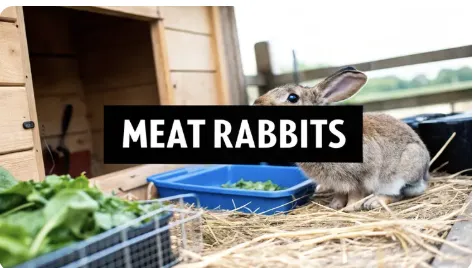
A Guide to Raising Rabbits for Meat
A Guide to Raising Rabbits for Meat
If you're looking for a way to produce your own protein that's efficient, sustainable, and doesn't require acres of land, raising rabbits for meat is one of the best projects you can take on. It's a real commitment, no doubt, but one that pays off with a freezer full of healthy, lean meat.
Why Raise Rabbits for Meat
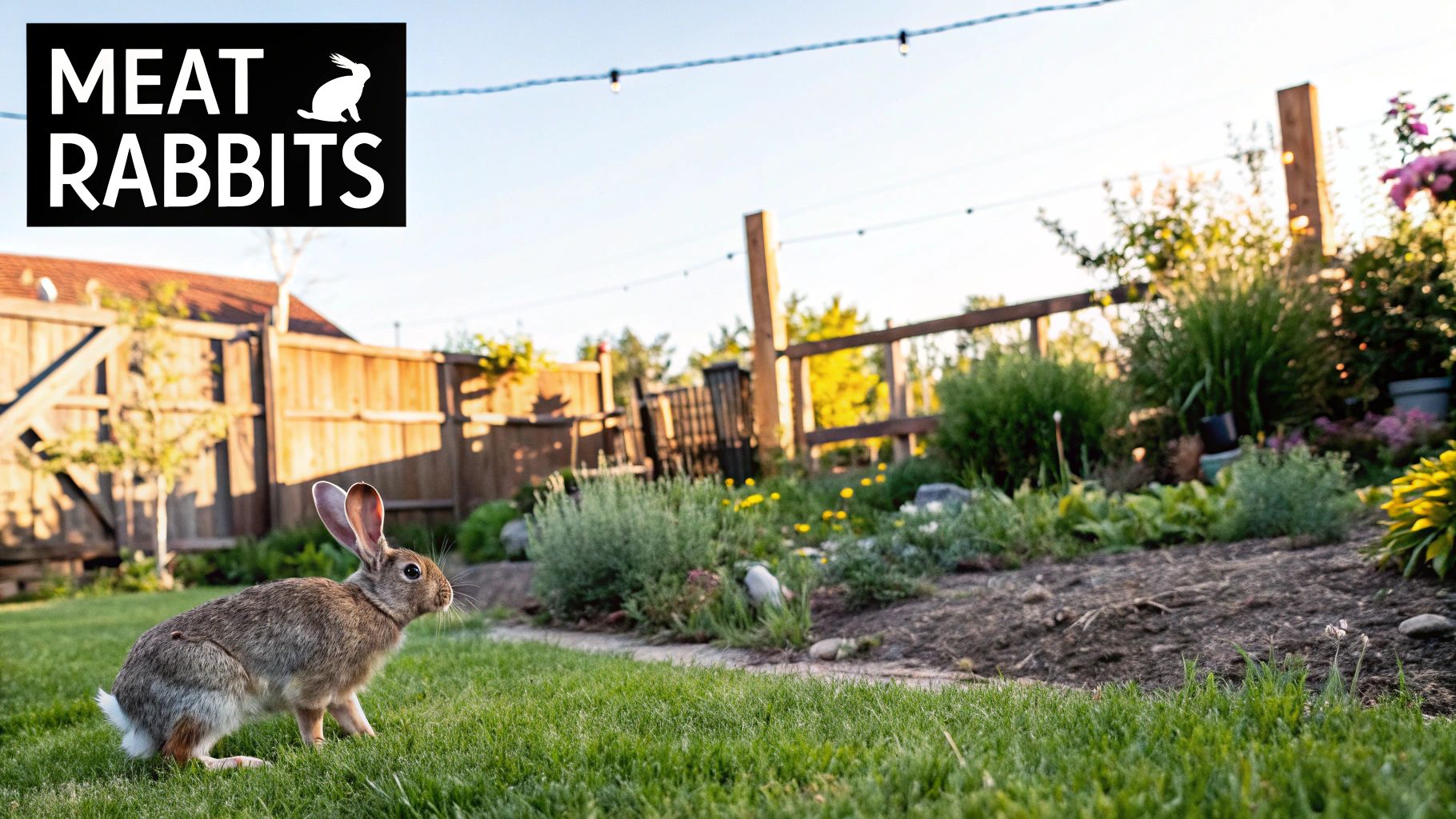
Jumping into raising your own meat is a big step toward self-sufficiency. Rabbits make a compelling case for both beginners and seasoned homesteaders because, unlike larger livestock, they don't demand a ton of space. A small, well-planned setup in your backyard or barn is all it takes to get started.
This accessibility makes raising rabbits for meat a practical entry point into homestead protein. The initial investment is relatively low, and the daily chores, while consistent, are pretty straightforward. A few minutes each morning and evening to check on feed and water is the heart of the routine.
Efficiency and Sustainability
One of the biggest reasons people turn to rabbits is their incredible efficiency. They have a stellar feed-to-protein conversion ratio, far better than cattle. This means you're spending less on feed to produce more meat, which makes the whole operation more sustainable and easier on the wallet.
Then there's the reproductive cycle—it's remarkably fast. A single doe can produce several litters a year, with each litter adding multiple kits to your herd. This quick turnaround means even a small-scale rabbitry can fill a freezer in a surprisingly short time, giving your family a steady supply of meat.
For many homesteaders, the combination of a small footprint, quiet nature, and high productivity makes rabbits an ideal choice. They integrate seamlessly into a diversified homestead without the intensive labor required by larger animals.
A Rewarding Homesteading Project
Beyond the practical perks, raising rabbits brings you closer to your food source. It's a hands-on lesson in responsibility, animal husbandry, and the realities of the food cycle. While processing day is never easy, it builds a profound respect for the animals and the nourishment they provide.
This isn't just a niche homesteading trend, either. The global demand for rabbit meat, valued at around USD 4.1 billion in 2025 and projected to grow, shows a broader shift toward sustainable, lean protein.
When you stack them up against other livestock, rabbits are often named among the best low-maintenance homestead animals for beginners thanks to their quiet demeanor and manageable size. This isn't just about meat; it's about building a more resilient and self-sufficient lifestyle, one litter at a time.
Choosing Your Ideal Meat Rabbit Breed
Picking the right rabbit breed is the first, and maybe most important, decision you'll make when raising rabbits for meat. While you can technically get meat from just about any rabbit, a few commercial breeds are the undisputed workhorses of the rabbitry. They've been bred for one thing: efficiency.
Your choice here directly impacts how fast you can fill your freezer and how much feed it takes to do it. The goal isn't just to raise rabbits; it's to raise a breed with a great meat-to-bone ratio, strong mothering instincts, and a calm enough temperament that they don't fight you every step of the way.
The Top Contenders for Your Rabbitry
For most folks starting out, the list gets real short, real fast. Three breeds consistently rise to the top: New Zealand Whites, Californians, and American Chinchillas. They aren't popular by accident; they're the result of decades of selective breeding for meat production.
New Zealand Whites are pretty much the gold standard. They're a large, all-white breed famous for their explosive growth, often hitting a processing weight of 5 pounds by 8-10 weeks. Their white pelts are also a practical bonus—any stray hairs left after processing are almost invisible on the carcass.
Californians are another top-tier choice. You can spot them easily by their white bodies and colored points (ears, nose, feet, and tail). They're a little smaller than New Zealands but are prized for their compact, meaty build and high dress-out percentage. Their smaller bone structure means you're getting more meat for your money.
The American Chinchilla is a fantastic heritage option that holds its own in a meat program. They grow a touch slower than the New Zealands or Californians, but they make up for it with incredible hardiness and excellent meat quality. Plus, their beautiful salt-and-pepper coat is a nice extra if you have any interest in using the pelts.
Understanding Key Production Traits
It's easy to get lost in the weeds comparing different breeds. To keep it simple, just focus on the traits that actually matter for putting food on the table.
Growth Rate: How quickly do the kits hit that target weight of 5-6 pounds? Faster growth means less feed per rabbit, which keeps your costs down.
Litter Size: How many kits does a doe consistently raise? An average of 8-10 kits is a solid target for production breeds.
Meat-to-Bone Ratio: This is all about how much usable meat you get compared to the weight of the skeleton. Commercial breeds are bred for a high ratio, meaning less waste.
Feed Conversion: How efficiently does the rabbit turn a scoop of pellets into body mass? This is where the top meat breeds really shine.
From my own experience, while a purebred New Zealand grows like a weed, a doe that consistently kindles and raises ten healthy kits is far more valuable than a faster-growing rabbit from a doe who only raises five. Don't ever overlook strong mothering instincts.
The Power of Cross-Breeding
One of the smartest moves you can make is to create "hybrid vigor" through cross-breeding. When you breed two different purebred rabbits, the offspring often grow faster and are hardier than either of the parent breeds. It's a well-known trick of the trade.
The classic, time-tested cross is a New Zealand White buck bred to a Californian doe. This combination is pure magic. You often get kits that inherit the rapid growth of the New Zealand and the excellent meaty confirmation of the Californian. These fryers can hit market weight faster and with more vigor than their purebred parents.
Another option involves a giant breed like the Flemish Giant. While not a primary meat breed themselves—they grow slow and have a massive bone structure—breeding a Flemish Giant buck to a New Zealand doe can produce some impressively large offspring. Just be warned, these bigger rabbits will take longer and eat a lot more feed to get to processing weight. For most homesteads, the New Zealand/Californian cross is simply the most efficient path to a full freezer.
Designing a Functional Rabbitry
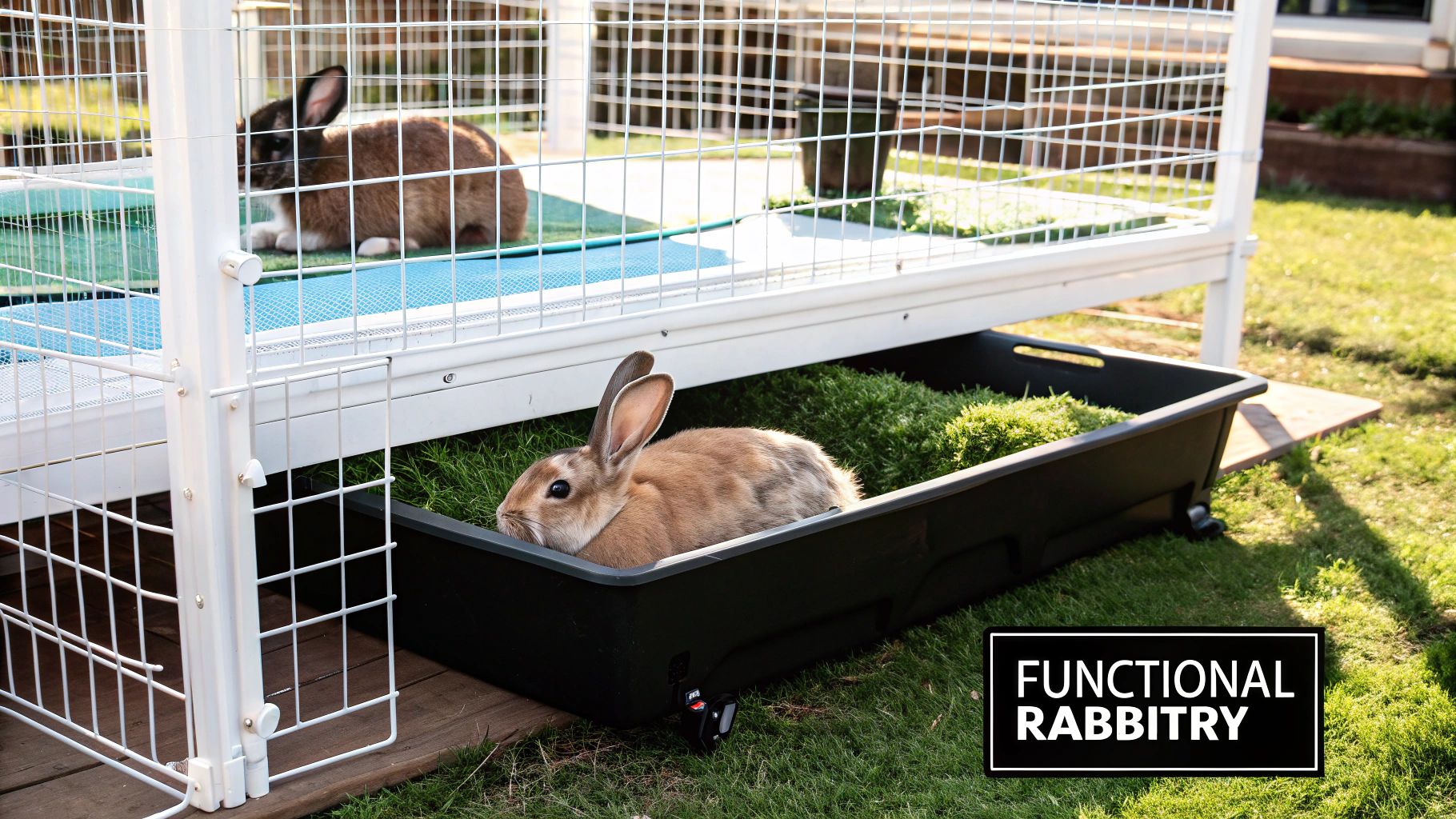
The long-term success of raising rabbits for meat hinges on a well-designed rabbitry. A functional setup doesn't just keep your rabbits healthy and safe; it makes your daily chores manageable instead of overwhelming. Think of it as designing a workspace—efficiency is everything.
Your rabbitry needs to protect your herd from three primary threats: predators, extreme weather, and disease. A smart design handles all three while simplifying feeding, watering, and the endless task of cleaning.
Housing Options: Wire Cages vs. Colony Setups
When it comes to housing, you generally have two main choices: individual all-wire hanging cages or a ground-based colony setup. Each has its own rhythm, and the one you pick will shape your daily management and the overall health of your rabbits.
All-wire hanging cages are the standard for most meat rabbit operations, and for good reason. They keep rabbits clean by allowing droppings to fall through the wire floor, which drastically cuts down the risk of diseases like coccidiosis. This design also makes it easy to do quick health checks and manage breeding since every rabbit is housed separately.
But the wire floor itself can be a major drawback. Without a solid surface to rest on, rabbits can develop painful sore hocks. Giving each rabbit a small plastic resting mat or an untreated pine board isn't optional—it's a non-negotiable step to prevent this common and painful condition.
A colony setup, where a group of rabbits lives together in a large, enclosed space, feels more natural. It gives them room to move and interact. While that sounds great, this method throws some major curveballs for a meat operation. It's tough to track breeding, spot a sick animal quickly, and prevent fights, especially among bucks.
For anyone serious about producing a consistent meat supply, I strongly recommend starting with all-wire cages. They give you a level of control and cleanliness that's vital for keeping a herd healthy and productive. Colony setups can work, but they demand a whole lot more management to get right.
Cage Sizing and Essential Gear
Cage size is absolutely critical for animal welfare. Overcrowding is a fast track to stress, poor growth, and disease. You'll want to stick to these minimums to give your rabbits the space they need:
Bucks & Does: A single cage should be at least 30" x 36" to provide enough room for a standard meat breed like a New Zealand or Californian.
Grow-Out Pens: A doe with her litter needs a much larger space. A "grow-out" cage that's 30" deep and 7 feet long can comfortably house a doe and her kits until weaning.
Beyond the cages, investing in the right equipment will save you countless hours. J-feeders hook onto the outside of the cage and hold a day or two's worth of pellets, keeping the food clean and cutting down on waste.
In that same vein, an automatic watering system with nipples is a total game-changer. It provides constant fresh water and gets rid of the daily chore of refilling bottles or crocks. For anyone looking for more detailed guidance on getting started, exploring resources on how to start a backyard rabbitry can give you a solid foundation.
Layout and Weatherproofing Your Rabbitry
How you arrange your cages really matters. Position them at a comfortable height—your back will thank you later—and make sure you have aisles wide enough to easily move with a wheelbarrow for cleaning. Good ventilation is also a must. A barn or shed with solid airflow helps dissipate heat in the summer and stops ammonia from building up.
Weatherproofing is another key piece of the puzzle. Rabbits handle cold far better than they handle heat. In hot climates, providing shade and ensuring constant airflow with a fan is critical, as temperatures above 85°F (29°C) can cause fatal heatstroke.
For winter, a three-sided structure that blocks wind and snow is usually enough. A simple hack is to wrap the cages in clear plastic sheeting to create a small greenhouse effect, trapping warmth while still letting in sunlight. This trick can make a huge difference in keeping your rabbits comfortable through the coldest months.
A Practical Guide to Rabbit Nutrition
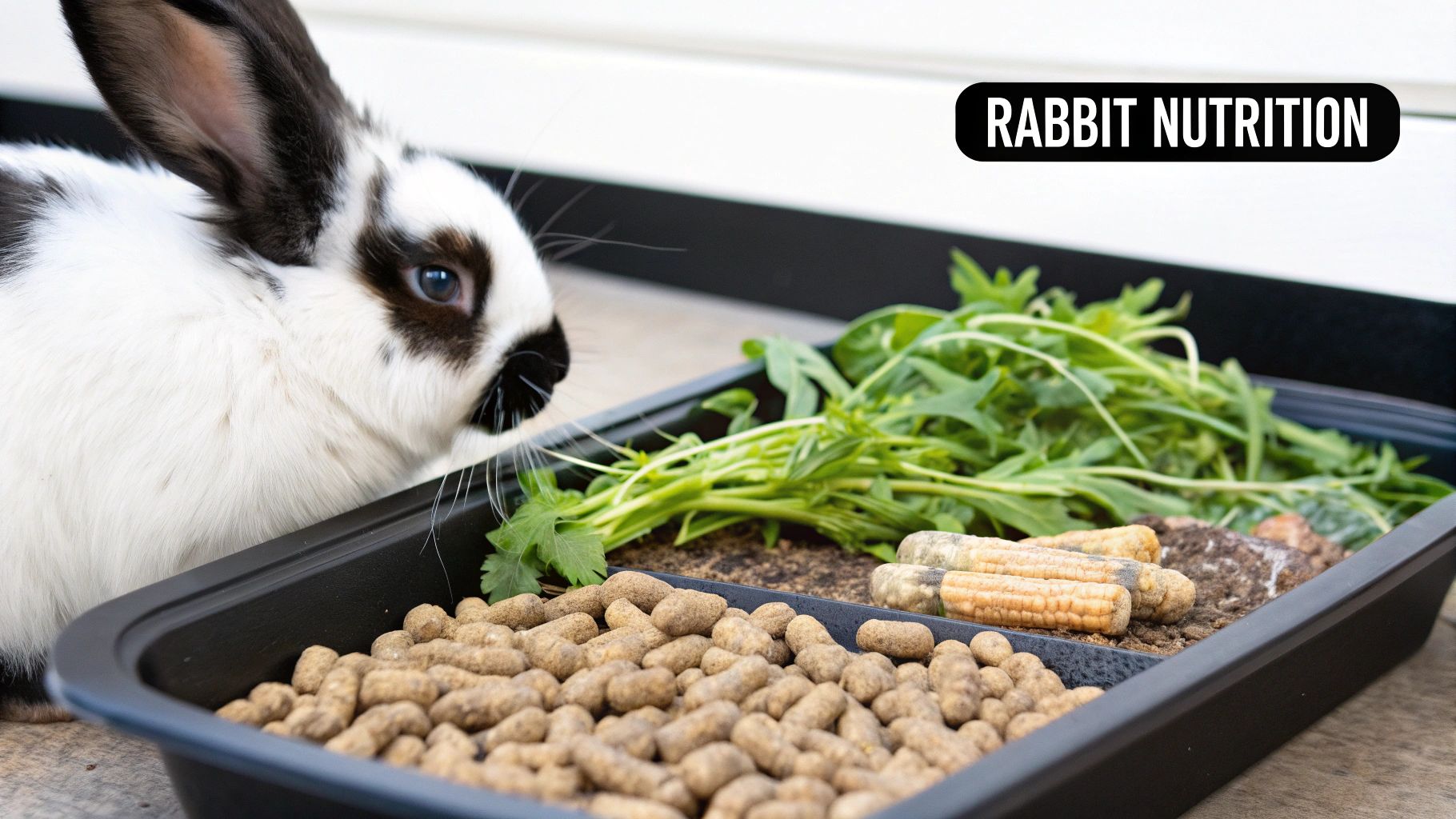
When it comes to raising meat rabbits, there’s one simple truth: what you put in is what you get out. Proper nutrition is the engine that drives your whole operation, influencing everything from how fast your kits grow to the size of your litters. It's a direct line—good feed equals good growth.
The foundation of any solid meat rabbit diet is a high-quality commercial pellet. This isn’t the place to cut corners. These pellets are formulated to deliver the right balance of protein, fiber, and essential nutrients your rabbits need to really thrive.
Decoding Commercial Rabbit Pellets
Standing in the feed store aisle can feel a little overwhelming. Ignore the flashy bags and go straight for the guaranteed analysis tag. For meat rabbits, you're looking for a specific profile to support rapid, healthy development.
Protein Content: Look for a feed with 16-18% protein. This is the sweet spot for growing kits and nursing does. Any lower and you'll see slow growth; much higher and you're just paying for protein they don't need, which can sometimes lead to digestive upset.
Fiber Content: This might be the most important number on the bag. You want a minimum of 18% crude fiber, but 20% or higher is even better. High fiber is absolutely critical for keeping a rabbit's gut healthy and preventing serious issues like GI stasis.
Always, always check the manufacturing date on the bag. Rabbit feed loses its potency over time, so you want the freshest pellets you can find and should aim to use them within a few months.
The Role of Hay and Safe Supplements
While pellets form the core of the diet, free-choice, high-quality grass hay is non-negotiable. It provides the long-stem fiber their digestive systems are built for, keeping everything moving smoothly and giving them something to do.
Timothy hay is a fantastic, easy-to-find option. If you're interested in growing your own high-protein forage, learning about cultivating alfalfa for feed can be a great move. Just be sure to feed alfalfa in moderation—it’s very rich and high in calcium.
Don’t treat hay as an occasional treat; it’s a daily necessity. A rabbit that is consistently eating hay is almost always a healthy rabbit. It's the best insurance you have against common digestive problems.
You can also offer small amounts of safe greens as a supplement. Things like dandelion greens, plantain weed, parsley, and cilantro are all excellent choices. Just remember to introduce any new foods slowly and in small amounts to avoid upsetting their delicate digestive balance.
Creating a Smart Feeding Schedule
Consistency is everything when feeding rabbits. Most growers feed a measured amount once or twice a day. As a starting point, a standard-sized meat doe might get 6-8 ounces of pellets daily, while a buck might only need 4-6 ounces.
But these are just starting points. You have to feed the rabbit in front of you.
A pregnant or nursing doe needs to be on "full feed"—meaning her feeder is kept full at all times to support her and her growing litter. On the flip side, you might need to cut back portions during a heat wave, as rabbits naturally eat less to avoid generating excess body heat.
Careful nutrition management is a timeless agricultural practice. While you're measuring out feed in your rabbitry, you're participating in a global food system. China, for instance, is the dominant force in the global rabbit meat market, both producing and consuming massive quantities. This global scale highlights how your local farming practices contribute to a much larger picture.
Managing Breeding and Kindling
A consistent breeding program is the real engine of a successful meat rabbit setup. Mastering the cycle of breeding, pregnancy, and kindling (when a doe gives birth) is what turns a few rabbits into a sustainable protein source for your family. The process itself is pretty straightforward, but it demands good timing and a sharp eye.
It all starts with knowing when your doe is ready. Unlike a lot of other animals, rabbits are induced ovulators, which just means the act of breeding is what triggers ovulation. A doe that's receptive will give you some clear signs: her vent will be a deep red or even purplish color, she might seem restless, and you'll often see her rubbing her chin on her cage and feeders.
The Breeding Process Simplified
The first rule of rabbit breeding is simple, and you never, ever break it: always take the doe to the buck's cage. Never the other way around. Does are fiercely territorial. If you drop a buck into her space, you’re far more likely to get a fight than a litter of kits.
Once she's in his cage, a willing doe and an experienced buck usually get the job done in less than a minute. You're looking for a successful "fall-off," where the buck mounts the doe and then literally falls off to the side, often with a grunt or a squeal. For good measure, I always wait for two successful fall-offs before I move the doe back to her own cage.
As soon as she's back, write down the date. Rabbit gestation is remarkably consistent, lasting 31 days on average. Mark your calendar for day 28—that’s your reminder to put a nest box in her cage.
A classic beginner mistake is leaving the doe and buck together unsupervised. It’s risky and totally unnecessary. A supervised breeding takes just a few minutes, keeps both animals safe, and lets you confirm that a successful mating actually happened.
Preparing for Kindling
Around day 28 of her pregnancy, it’s time to give the doe her nest box. A simple wooden or wire box filled with clean, dry pine shavings or straw gives her a safe, warm spot to build her nest. Don’t be surprised if she immediately digs it all out; that’s completely normal. Just refill it for her.
In the days right before she kindles, a doe with good mothering instincts will start pulling fur from her chest and dewlap to line the nest. This fur is the perfect insulator for keeping newborn kits warm. A doe who pulls a lot of fur is usually a good sign you've got a great mother on your hands. This natural cycle of quick reproduction is a major reason rabbit farming is a growing part of the livestock world. The global market, which covers meat, fur, and lab animals, hit a value of USD 1.68 billion in 2024 and is expected to climb to USD 3.26 billion by 2035, all thanks to the rabbit's efficiency. You can discover more insights into the rabbit farming market to get a better handle on its economic impact.
Managing the Newborn Litter
Kindling almost always happens at night or in the very early hours of the morning. The best thing you can do is give the doe her privacy. Once you think she's given birth, quietly and calmly check the nest box.
Here’s a quick checklist for that first look:
Count the kits: Gently remove any that were stillborn or look obviously underdeveloped.
Check for warmth: A good mom will have them all piled together in a cozy bundle under a thick blanket of her fur.
Look for full bellies: Healthy, nursing kits will have round, milk-filled tummies.
If you find a few kits scattered on the cage floor, they probably fell out of the box while nursing. Gently warm them up in your hands, put them back in the nest, and tuck them back under the fur with their siblings. It’s a good idea to check on the litter daily for the first week to make sure everyone is warm, fed, and thriving.
Humane Processing and Handling Meat
This is the part of the journey that asks the most of us. It requires respect, a solid plan, and a calm confidence that you can only get through preparation. When you raise an animal for your table, approaching this final step with a clear, humane method is your responsibility. It’s about ensuring the animal's life ends quickly and without any undue stress.
The goal is always a swift, clean process. For most folks raising rabbits on a small scale, the most common and ethical way to dispatch is cervical dislocation. When you do it right, it's instantaneous and painless. I can't stress this enough: learn this technique from someone experienced or from detailed, reputable video guides before you ever attempt it. Hesitation is the enemy here; confidence and decisiveness are what make it humane.
The Essential Steps from Dispatch to Freezer
Once the dispatch is done, the work of turning the animal into clean, healthy meat for your family begins. This is where you'll skin, eviscerate, and chill the carcass. You'll want a dedicated, clean workspace ready to go with sharp knives, a bucket for the offal, and easy access to clean water.
Food safety is everything at this stage. Learning how to properly prevent cross-contamination isn't just a good idea—it's a critical skill that protects your family's health. Always keep separate surfaces for different tasks and get in the habit of washing your hands and tools often.
An experienced hand can get from dispatch to a fully cleaned carcass ready for the ice bath in about 10-15 minutes. Your first few times will take longer, and that's okay. Focus on being thorough and clean, not fast.
After the rabbit is skinned and eviscerated, the next two steps are absolutely critical for the quality and safety of the meat. This infographic breaks down the timeline you'll need to follow.
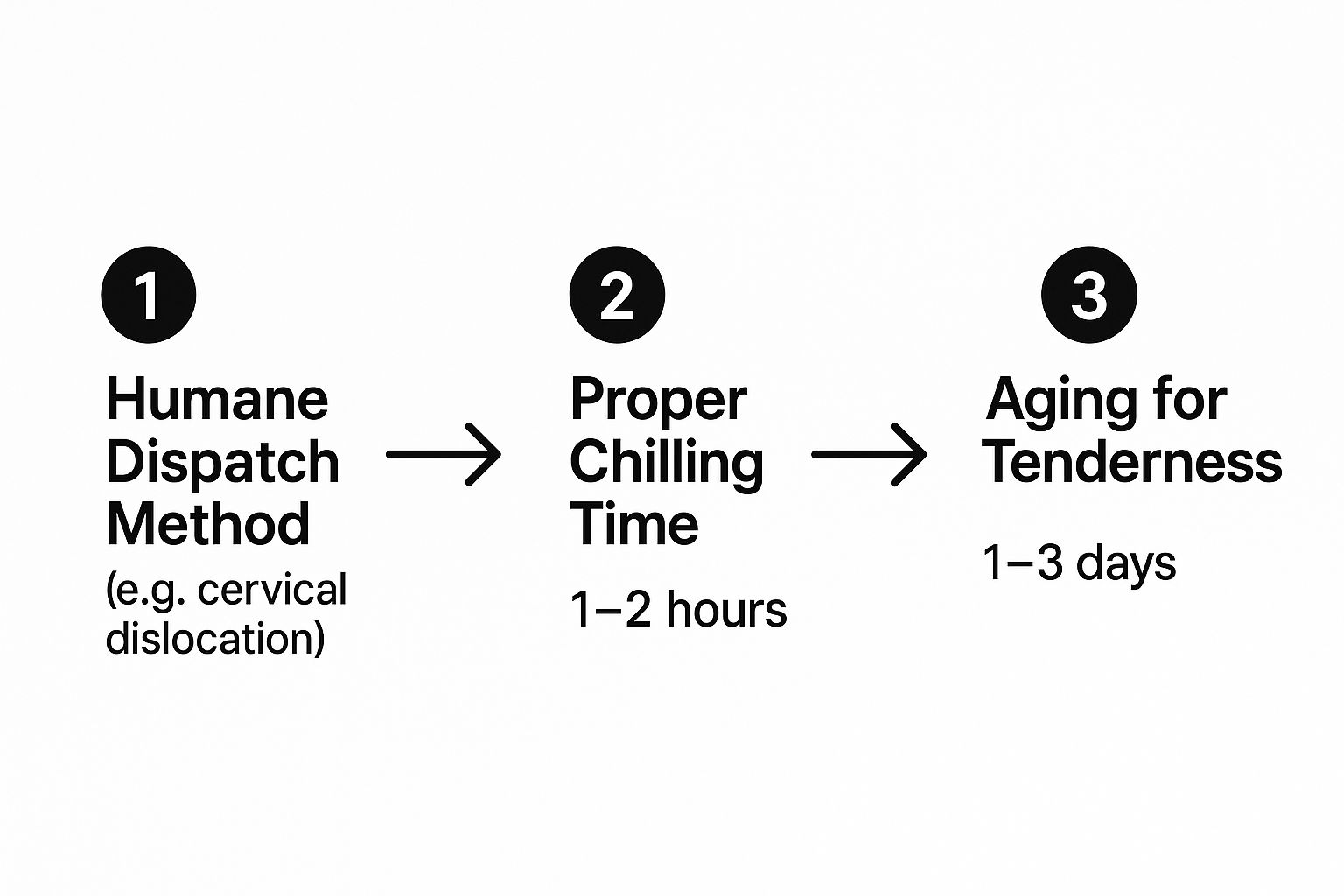
As you can see, the work doesn't stop once the carcass is clean. Proper chilling and aging are non-negotiable if you want tender, high-quality meat.
Chilling and Aging for Tenderness
Right after processing, you need to get that carcass chilled down—fast. This stops bacterial growth in its tracks. The best way is to submerge it completely in a bath of ice water for at least an hour or two, until it's cold all the way through to the bone. This rapid chill is a cornerstone of safe meat handling.
Now for the most overlooked step by beginners: aging. Please, do not skip this. Once the carcass is thoroughly chilled, move it into a refrigerator set between 34-40°F (1-4°C) and let it rest for one to three days. This allows the muscles, which tighten up during rigor mortis, to relax. At the same time, natural enzymes get to work breaking down connective tissues. This is what transforms potentially tough meat into a tender, flavorful meal.
After it has aged properly, you can finally butcher the rabbit into your desired cuts—saddles, legs, quarters—and package it for the freezer. A vacuum sealer is your best friend here; it’ll prevent freezer burn and keep the meat in prime condition for up to a year. And for those of you aiming for even greater self-sufficiency, you can also explore different ways for how to preserve meat without refrigeration.
Common Questions About Raising Meat Rabbits
Even with a solid plan, a few questions always pop up when you're getting started with a new homestead project. Let's tackle some of the most common ones right now so you can feel confident diving into raising rabbits.
How Much Time Does It Take Daily?
This is one of the biggest—and most important—questions people ask. For a small setup with one buck and two or three does, you’re looking at about 10-15 minutes a day.
Most of that time is spent checking feeders, making sure the water lines are flowing freely, and doing a quick visual health check on each rabbit. It's a simple routine that easily fits into a morning or evening.
Of course, cleaning adds a bit more time, but if you’ve built your cages with wire bottoms, a deep clean is only needed every week or two.
The real time sink is processing day, but that’s an infrequent, focused event. The daily tasks are short and sweet.
What Does Rabbit Meat Taste Like?
If you’ve never tried it, you’re probably curious. Rabbit is a very lean, all-white meat with a delicate, fine-grained texture. Most people compare it to chicken, but it’s milder and has a subtle sweetness you won’t find anywhere else.
Because it’s so lean, it does best with cooking methods that lock in moisture. Think about things like:
Braising in a savory broth or wine
Slow-cooking in a crockpot until it’s fall-off-the-bone tender
Frying with a good coating to keep it juicy
Rabbit is incredibly versatile and soaks up the flavors of whatever herbs and spices you cook it with. It's a fantastic addition to any kitchen.
Ready to build a thriving homestead? The Grounded Homestead provides the practical guides and insights you need to grow your own food and live more sustainably. Explore our resources at https://thegroundedhomestead.com.


Facebook
Instagram
X
Youtube